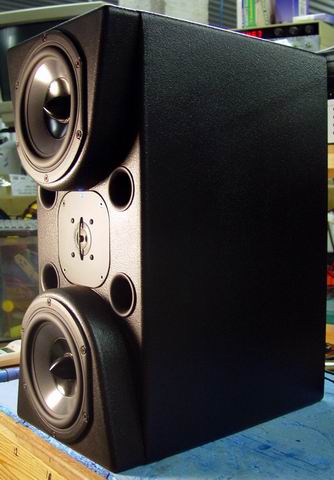Long gone topic...
I have three options and a lot of questions, if somebody could answer... Just cannot decide what I want, so need some fresh look from outside.
Right now I am trying to decide what close field monitors to have.
At present I am working with Jordan monitors--4" woofers. If you know the Jordans, it is pretty freaky staff. The woofer's x-max is about probably at least 7-8 mm. They are quite accurate, however I feel they are little bit too "musical". With some body dampening they are much closer to what I want them as monitors.
However, I still think the bass could go deeper.
Many years ago I wanted to try D'Appolito configuration, and out of 2" MDF I built enclosures for 5 1/2" woofers. I had in mind treated paper cone Audaxes. I built the enclosures, but never even got the drivers. The question:
I never had chance to listen to D'Appolitos, so what your impressions about it compare to conventional 2 driver design? I understand, it is hard to answer, as for the fair comparison many factors need to be matched. But anyway, anybody?
My dilemma is like this: for tweeters I could use ribbons I built, or as an alternative, my favorite Heil air motion trasformers. I also have a Rane 22 crossover with upgraded signal chain capacitors, and set of two amplifiers... and lots of MDF and wood.
I'd like to stay within $200--$250 max budget for woofers and my choices are:
1) For $160 to get four 5 1/2" Audaxes once I had in mind, and using the ribbon or Heil staff for tweeters, with my already built enclosure, to finish D'Appolito.
2) For around $250 to get a nice pair of 6,5-7" woofers, and together with my ribbon/Heil to design a new box?
On the other hand, is the D'Appolito so much superior? Should I wait to save some more $$$ and build something like a Thor with Seas drivers from Madisound?
The scary staff is that often the more expensive staff does not necessarily mean a better quality.
Either way, it will be biamped, with electronic crossover, for easy tweaking.
Oh my!!! I almost sound like on homerecording.com: "What would be the best mic for under $100".













![Soldering Iron Kit, 120W LED Digital Advanced Solder Iron Soldering Gun kit, 110V Welding Tools, Smart Temperature Control [356℉-932℉], Extra 5pcs Tips, Auto Sleep, Temp Calibration, Orange](https://m.media-amazon.com/images/I/51sFKu9SdeL._SL500_.jpg)






















